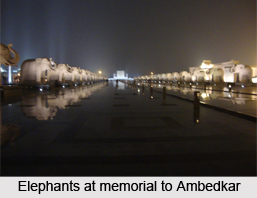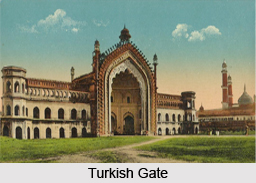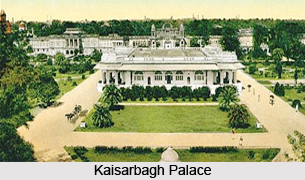 Lucknow, the capital city of the state of Uttar Pradesh, is the administrative centre of Lucknow District and Lucknow Division. This city is popular for its multicultural identity. Beautiful gardens, courtly manners, music, poetry, and exotic cuisine of Lucknow are well known throughout the country and abroad. This city is also regarded as the `The City of Nawabs`, `Golden City of the East` and `The Constantinople of India`. This vibrant city has witnessed a tremendous economic boom over the years and is rated among the top ten developing metro cities of the country. This lavish city is renowned for its depth in the field of Urdu and Hindi literature. Lucknow also has several historical monuments and sites that attract the people from various regions of the world.
Lucknow, the capital city of the state of Uttar Pradesh, is the administrative centre of Lucknow District and Lucknow Division. This city is popular for its multicultural identity. Beautiful gardens, courtly manners, music, poetry, and exotic cuisine of Lucknow are well known throughout the country and abroad. This city is also regarded as the `The City of Nawabs`, `Golden City of the East` and `The Constantinople of India`. This vibrant city has witnessed a tremendous economic boom over the years and is rated among the top ten developing metro cities of the country. This lavish city is renowned for its depth in the field of Urdu and Hindi literature. Lucknow also has several historical monuments and sites that attract the people from various regions of the world.
At Lucknow, for instance, Asafi Imambara, which is also known as known as Bara Imambara, Chhota Imambara, Shah Najaf, etc. are the popular monuments of architectural importance. Some other interesting places of exploration at this city are Chattar Manzil, Dilkusha, Picture Gallery, State Museum, Shaheed Smarak, Ambedkar Memorial, Planetarium, and more. Some of the monuments with architectural importance built in the British era in Lucknow comprise the `Vidhan Sabha` (State Legislative Assembly), the Charbagh Railway Station, with its unique domes, pillars and arches, St Joseph`s Cathedral and Clock Tower.
The `Dilkusha` or Heart`s Delight was built by Saadat Ali Khan in between 1798 to 1814 as a hunting-box in the centre of a large wooded park. It was constructed in a classical European style with square corner towers. But, it is now a ruin set among flower gardens.
In the south-west of Dilkusha lies the `Bibiapur Kothi`, which is a two-storey building designed by architect Claude Martin. It is presently a Government Dairy Farm. To the north-west of Dilkusha stands `La Martiniere Boys` School`, formerly Constantia, one of the most fascinating buildings in the city. It was designed as a palace-tomb by Major-General Claude Martin (1735-1800). Constantia is a huge building with the most peculiar hybrid design. It is situated on a massive platform and it comprises a symmetrical block with curved semicircular wings added in the year 1840. The first storey has corner pavilions and statuary in full silhouette on the skyline. Another popular monument is Christ Church (1860) was designed by General Hutchinson as a memorial to the Mutiny dead and was enlarged and improved in the year 1904. It consists of many fascinating memorial tablets and brasses.
Bara Imambara is considered as the largest domed hall of the world. This monument significantly tells about the glory of the past. It was designed by Kifayat-ullah for Asaf-ud-Daula in the year 1784 as a famine-relief measure. It is one of the most impressive buildings in India, dominating the north-west corner of the city. An imambara is the general term for a building in which the festival of Muhar-ram is celebrated, and sometimes, as here, used for a mausoleum. It is approached through a square gateway crowned by an octagonal pavilion, from which two courtyards raise one above the other and linked by wide flights of steps. A lofty mosque with two minarets surrounds the west side. Over the main chamber a staircase leads to a series of rooms and passages designed as a maze, above which is a flat roof from which magnificent views of the city can be obtained. Outside the Great Imambara and straddling the road is the Turkish Gate or Rumi Darwaza that is a 60 feet high doorway. It is another very beautiful monument of Lucknow. It was constructed by Asaf-ud-Duala in between 1784 to 1786. It harmonizes with the adjoining Great Imambara to produce a wonderful complex of Oriental forms.
The Khurshid Manzil or House of the Sun, presently La Martiniere Girls` School, was constructed in between 1800 and 1810 by Saadat Ali Khan. It was ultimately completed by his son. This building was designed in a hybrid European style; it has six irregular towers and four entrances. `Shah Najaf`, tomb of Ghazi-ud-Din Haidar (1814-27) is an impressive building crowned by a white dome and glittering gold pinnacle. Its interior is richly decorated with crystal chandeliers and portraits, and contains the silver tomb of the Nawab flanked by two of his wives. This monument is beautifully illuminated during Muharram and on the anniversary of the death of his favourite wife.
At the north-west of `Shah Najaf` is the Moti Mahal or the Pearl Palace. It is so called because of its resemblance of its original dome, which is now destroyed, to the shape of a pearl. It is a two-storey building. Originally, it comprised three distinct buildings: the Moti Mahal on the north side, built by Saadat Ali Khan, and the Mubarak Manzil and Shah Manzil, built by his son on the river frontage. The Italian wrought-iron entrance gates of this monument were installed in the year 1923. The Chattar Manzil or Umbrella Palaces are other impressive monuments of Lucknow. They were named so for their distinctive triple umbrella pavilions, which ornament the domes. They are highly impressive. Nearby is the Post and Telegraph Office, which was designed by Henry Lanchester. To the north lies the `Sher Darwaza` or Tiger Gateway, another historical site of this city. Beyond lies the British Residency, one of the best known historical monuments of Lucknow. It was built in 1800 by Saadat Ali Khan. Beneath and is well known for its distinct architectural styles. The Residency stands on the north-east side of the enclosure with its famous battered tower. The ground floor houses a small museum, which has a model showing the entire position in 1857.
North-west of the British Residency is the Iron Bridge (1798), designed by Sir John Rennie. Its design was based on the design of a similar bridge over the Witham at Boston in Lincolnshire. To the north-west again are King George`s and Queen Mary`s Medical Hospital and College (1912), built by Sir Samuel Swinton Jacob in a complete Indo-Saracenic style. Nearby is the Hardinge Bridge (1914), which replaced an earlier structure, which was erected in 1780 by Asaf-ud-Daula, and also the Mosque of Aurangzeb.
 Just beyond the Rumi Darwaza are a number of neglected British tombs adjoining Victoria Park (1890). There is the Husainabad Clock-tower (1881) carrying the largest clock in India. The `Husainabad Imambara` or Palace of Lights (1837) has a magnificent appearance when illuminated. It stands in a large quadrangle and is well-detailed from each and every aspect. It was built by Muhammad Ali Shah (1837-1842). Another delightful monument of Lucknow is Juma Masjid, which was erected by Muhammed Ali Shah. This monument is also known as picture gallery as it contains the pictures and portraits of former Nawabs and Kings. Kaisarbagh Palace (1848-50) was founded by Wajid Ali Shah. It is also considered as a well renowned monument of this city. Outside the west gateway of the palace is the Roshan-ud-Daula Kothi. To the north-east of Kaisarbagh Palace is the Maqbara of Saadat AH Khan (1814). There are two virtually identical tombs with fine silhouettes, the larger being the king`s, the smaller that of his wife, Khursid Zadi.
Just beyond the Rumi Darwaza are a number of neglected British tombs adjoining Victoria Park (1890). There is the Husainabad Clock-tower (1881) carrying the largest clock in India. The `Husainabad Imambara` or Palace of Lights (1837) has a magnificent appearance when illuminated. It stands in a large quadrangle and is well-detailed from each and every aspect. It was built by Muhammad Ali Shah (1837-1842). Another delightful monument of Lucknow is Juma Masjid, which was erected by Muhammed Ali Shah. This monument is also known as picture gallery as it contains the pictures and portraits of former Nawabs and Kings. Kaisarbagh Palace (1848-50) was founded by Wajid Ali Shah. It is also considered as a well renowned monument of this city. Outside the west gateway of the palace is the Roshan-ud-Daula Kothi. To the north-east of Kaisarbagh Palace is the Maqbara of Saadat AH Khan (1814). There are two virtually identical tombs with fine silhouettes, the larger being the king`s, the smaller that of his wife, Khursid Zadi.
There are several popular Dargahs or shrines in Lucknow. For instance, the Dargah of Hazrat Abbas is surrounded by pillared doorway. The Tomb of Ibrahim Chishti is another very popular monument of this city of Nawabs. St Mungo`s Church of Scotland (1909), All Saints` Church (1913) and the Railway Church (1915) are some of the churches of the British era.
The popular monuments of Lucknow symbolize the rich past and depth of the city. These monuments give a wonderful way to explore the history of the state.




